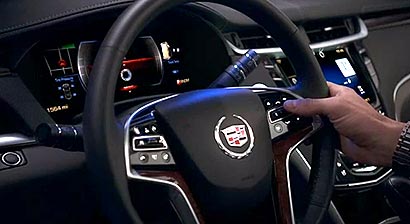automotive
Cadillac CUE To Make Console IPad-Like
- by Karl Greenberg , May 9, 2012

Cadillac is radically changing how the automobile instrument panel looks and functions, making it less like an instrument cluster and more like the touch-sensitive screen of an iPad. A new information/entertainment platform called CUE (Cadillac User Experience) that will be standard in forthcoming XTS and ATS cars includes a redesign of both the screen on the control pillar to the right of the driver and the usual gauges behind the steering wheel.
Among other things, the CUE system allows drivers to change the layout of those gauges because they will be entirely virtual, and even are designed to tumble out of a virtual abyss onto the console surface when the ignition key is depressed. The entertainment and GPS screen on the center console is also customizable, and was designed to function like, say, an iPhone or Droid.
The automaker says the CUE center screen and control panel represent the first automotive use of capacitive touch that brings in familiar multi-touch gestures. The system pairs with up to 10 mobile devices.
Cadillac is giving buyers of the forthcoming XTS sedan a new iPad -- a physical one -- to help them learn the system, and will launch an app to tout CUE. These are two elements of an array of technology and services the General Motors luxury division is offering to support the rollout of CUE. The iPad that comes with the XTS will also have the MyCadillac App and OnStar RemoteLink. There is also a microsite with videos showing how the system works.
The automaker sent out 25 or so "Connected Customer Experts" to dealerships around the country to train sales staff on how to talk about CUE to prospects. Caddie is doing likewise at its customer assistance services center in Austin, Texas.
Jim Vurpillat, Cadillac global marketing director, explains to Marketing Daily that rather like an iPad, the platform is meant to be plug and play. "We have this term we like to use," he says. "It's as simple and easy to use as you need it to be and as technically sophisticated as you want it to be."
Vurpillat says that like a smartphone, the center entertainment and info screen uses capacitive touch, active feedback (which creates a Droid-like tactile pulse when the user selects a virtual button or icon), and proximity sensing (which allows the screen to reflect one function at a time when in use because it brings buttons and choices back into view automatically when the user's finger draws near.)
He says the effect of the enhancements -- including the way that the 12.3-inch reconfigurable instrument cluster behind the steering wheel launches from a black screen -- "is very dramatic; there's a little bit of theatre to it."
Some of the advertising for the XTS will focus on that light show aspect of the instrument cluster as well as on its tablet-like functionality. "It's definitely one of the the highlight features. We will run TV spots that talk about the ease of use -- the simplicity of it," he says. One spot will start by making a comparison between the button-laden console of a competitive vehicle, and then transition to a "Now count the number of buttons on your tablet," message. Says Vurpillat, "It focuses right on CUE and comes back to the correlation that CUE is like a tablet for your car." He adds that another forthcoming spot will talk about how a user can change screens, controls and perspectives with finger gestures and swipes.


